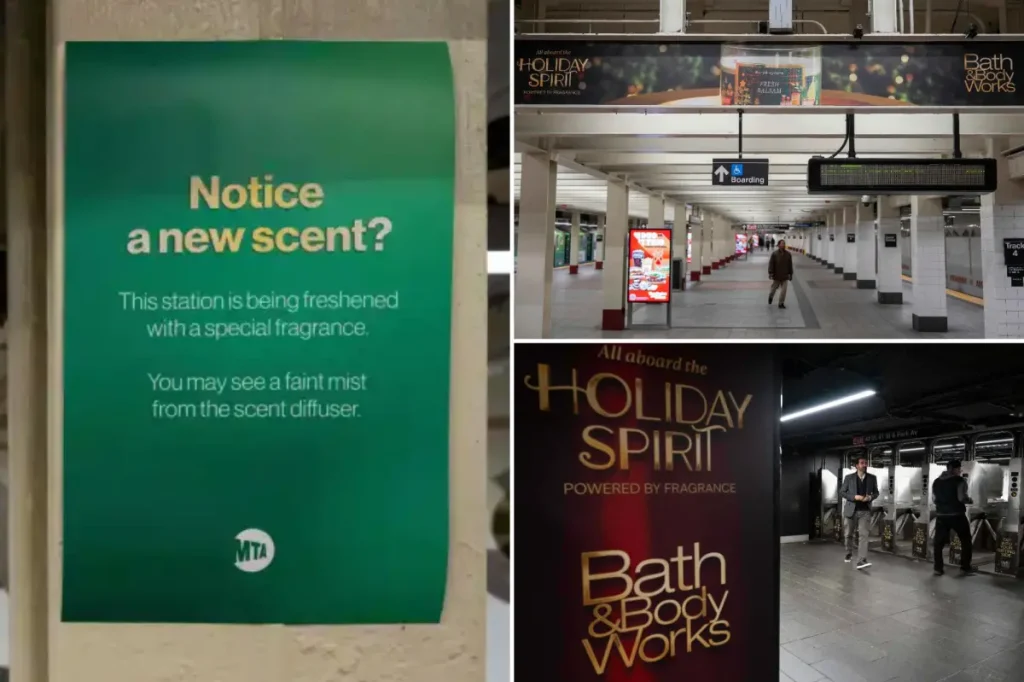A Scented Ride: Bath & Body Works Brings Holiday Cheer to New York City Subway
New York City’s subway system has long been infamous for its distinctive and often unpleasant array of smells. From industrial fumes to bodily odors, the olfactory experience of commuting through America’s largest transit system has rarely been described as pleasant. But this holiday season, something unusual is happening beneath the streets of Manhattan. Commuters passing through Grand Central station are being greeted not by the typical subway scents but by wafts of vanilla and fresh pine. This surprising sensory shift is the result of an innovative advertising campaign by Bath & Body Works, which has installed diffusers along the 42nd Street shuttle train platform. The retail chain is pumping its “Fresh Balsam” fragrance—one of its most iconic holiday scents—into the busy transit hub throughout November, creating a stark and welcome contrast to the usual subway atmosphere. The campaign represents a first-of-its-kind approach to advertising in New York City’s transit system, with Bath & Body Works estimating that between 20 to 30 pounds of fragrance will be dispersed by the end of the month.
The scented campaign has transformed one of the most congested sections of Grand Central station, where thousands of commuters rush to and from the Times Square shuttle every few minutes. Most riders don’t immediately notice the diffusers mounted on steel girders above the platform and along the walls of the connecting tunnel, though observant passengers can spot them releasing visible bursts of fragrant vapor. The scent itself is subtle—noticeable enough to create a pleasant atmosphere but not overwhelming. Many commuters describe it as “pine-scented” and “very Christmassy,” while others liken it to fabric softeners. The gentle nature of the fragrance means some busy travelers miss it entirely as they hurry through the space, and without the explanatory posters, one might easily mistake it for another passenger’s perfume rather than a deliberate advertising initiative. This subtlety appears to be by design, creating an ambient experience that enhances rather than disrupts the commuting environment.
Passenger reactions to this aromatic intervention have been largely positive, offering a refreshing change from the typical complaints about subway conditions. Jerome Murray, a regular commuter, expressed appreciation that the fragrance “smells better than the normal New York City tunnels that we normally smell here.” Kelly Rodriguez, a 23-year-old rider, noted the “very Christmassy” pine scent, echoing the observations of many others traveling through the station. The campaign seems to have achieved a delicate balance—noticeable enough to create a positive impression but not so overpowering as to become an irritant. This gentle approach to scent marketing appears designed to create positive brand associations without disrupting the commuting experience, demonstrating an understanding that in the close quarters of public transit, subtlety is key.
The Metropolitan Transportation Authority (MTA), which operates New York City’s subways and buses, has embraced this novel advertising approach as part of its strategy to develop new revenue streams. However, cognizant of potential criticism, the agency proceeded cautiously, conducting pilot tests of aroma-based advertisements at stations in Queens and Brooklyn before implementing the current campaign. These preliminary tests allowed officials to assess safety considerations and gather public feedback. Mary John, the MTA’s director of commercial ventures, reports that the agency has not received any complaints about the scented advertising initiative thus far, suggesting that the careful implementation has paid off. This positive reception marks an important milestone for the MTA as it explores innovative ways to generate revenue beyond traditional transit advertising formats like posters and digital displays.
From the advertiser’s perspective, the campaign represents a strategic approach to holiday marketing. Jamie Sohosky, Bath & Body Works’ chief marketing officer, explained that “Fresh Balsam” was selected for the campaign because it is a long-running seasonal favorite among the brand’s customers. The choice of Grand Central station was equally deliberate, targeting one of the city’s busiest transit hubs where countless riders make connections to other trains. This approach to sensory marketing creates a direct connection between the brand and potential customers, allowing people to experience the product in a way that traditional visual advertisements cannot match. By associating their fragrances with the positive experience of holiday scents in an otherwise unscented environment, Bath & Body Works creates a memorable brand interaction that stands apart from the visual noise that typically dominates advertising spaces.
This scented subway campaign points to a possible future direction for advertising in public spaces, where brands engage multiple senses rather than just relying on visual communication. In a world saturated with screens and images competing for attention, olfactory marketing offers a distinctive way to create emotional connections with consumers. For Bath & Body Works, a retailer whose products are designed specifically to appeal to the sense of smell, this approach aligns perfectly with their brand identity. For the MTA, it represents an innovative source of revenue that, if well-executed, could enhance rather than detract from the passenger experience. As the holiday season progresses, commuters rushing through Grand Central station might find themselves momentarily transported from the underground world of the subway to a pine-scented winter wonderland—a small but meaningful transformation of public space that benefits travelers, the transit authority, and the advertiser alike. This harmonious balance of interests suggests that sensory advertising, when thoughtfully implemented, might have a promising future in urban transit systems.










